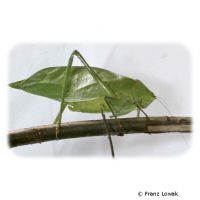Giant Katydid (Stilpnochlora couloniana)
| Giant Katydid Stilpnochlora couloniana | |
|---|---|
| Name | Giant Katydid |
| Name Lat. | Stilpnochlora couloniana |
| Family | Long-horned Grasshoppers |
| Family lat. | Tettigoniidae |
| Order | Grasshoppers |
| Order lat. | Orthoptera |
| Origin | North America |
| Habitat | Forest |
| Diet | Fresh rose-family leaves |
| Humidity | 70-90 % |
| Behavior | Nocturnal, peaceful |
| Keeping | Individual, pair, group |
| Care Level | Easy |
| Housing | Humid terrarium |
| Breeding | Simple |
| Life Span | 12 months |
| Protection | No |
| Metric Units | |
| Size | 7-8 cm |
| Temperature Day | 24-27 °C |
| Temperature Night | 22-24 °C |
| Housing Size | 30 x 30 x 50 cm |
| US Units | |
| Size | 2.8"-3" |
| Temperature Day | 75-81 °F |
| Temperature Night | 72-75 °F |
| Housing Size | 10" x 10" x 20" |
Distribution and habitat
The crepuscular to nocturnal Cuban Giant Leafhoppers are distributed from Florida to Cuba and some islands in between. There the well camouflaged animals live in the foliage of bushes and trees.
Maintenance
A terrarium of L 30 x W 30 x H 50 cm is recommended for a pair or a small group. A terrarium with a cover made of gauze or fine metal mesh is best. The terrarium should be placed in a quiet place without sunlight
They need climbing opportunities, such as cork back walls, twigs and branches, which also serve as food plants. In order to keep them fresh for a longer time, they should be served in narrow-necked, well-sealed (danger of drowning), stable containers (e.g. vase). Suitable substrate is terrarium humus or a soil-sand mixture covered with moss, which should always be kept slightly moist. Daily, preferably in the evening, the insectarium should be finely sprayed with water inside (humidity), but a rain or fog system is better. Waterlogging should be avoided at all costs. Good ventilation is especially important.
| Daytime temp: 24-27 °C | Temp. night: 22-24 °C | Humidity: 70-90 |
Although the animals are nocturnal, a light source that also produces the necessary heat is ideal. The lighting duration should be 8-12 hours, depending on the season
Diet
The food supply consists of fresh leaves of blackberry, honeysuckle (Lonicera nitida), laburnum, elderberry and ivy (Hedera helix), as well as leaves of ferns. Leaves of other roses and rose plants, such as red and hawthorn, raspberry, currant, wild rose, etc., as well as the leaves of beech, oak, linden, hazel, eucalyptus or sweet chestnut are also accepted differently by individuals. Blackberries are ideal as food in winter, as they remain green. Spraying the forage plants allows the animals to satisfy their drinking needs. Additionally, a wick waterer is recommended. Eaten branches, dried and rotten leaves must be removed regularly
A varied diet promotes the well-being of the animals.
Reproduction and breeding
The females have a laying tube about 5 mm long and are somewhat larger and bulkier than the somewhat slimmer males. Both sexes have leaf-like wings that extend far beyond the body.
About 3-4 weeks after mating, females attach their eggs (20-50 of them) to feeding branches or leaf edges. The young hatch after about 4-6 weeks, they are blue-green and have long legs and antennae. Freshly sprouted blackberry leaves are good as initial food.
After the last moult (imaginal moult) the animals live up to 12 months
Important
The Cuban Giant Leafhopper is very similar to a green leaf by coloration and body structure (leaf mimesis) and is well camouflaged from predators. Adults can fly very well and larvae can jump very well.
Before purchasing, a terrarium should be prepared that meets the species specific needs. Good ventilation without drafts is necessary, as well as equipment for measuring temperature and humidity. The lighting has to correspond to the species-specific day-night rhythm and should be placed in such a way that the animals cannot injure themselves
The terrarium should be locked in such a way that neither unauthorized persons can open it nor the animals can escape. Special attention must be paid to thorough hygiene and impurities must be removed regularly
Further literature can be found in your pet store
References
Text: petdata; Image: Franz Lowak
Source: SEILER, BRADLER, KOCH (2000): Ratgeber Phasmiden, Verlag Bede; ENGELMANN & LANGE (2011): Zootierhaltung - Tiere in menschlicher Obhut: Wirbellose, Harri Deutsch Verlag
